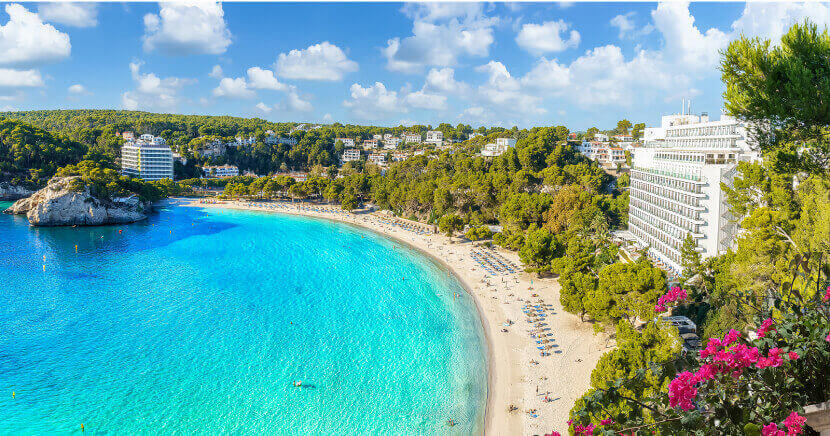Ask most people if they support sustainable travel, and they'll likely respond, “But, of course!” But do those travelers really know what that means?
According to the 2023 Sustainable Travel Report from Booking.com, 80% of survey respondents confirm that traveling more sustainably is important to them, with 76% reporting that they want to travel more sustainably over the next 12 months. Despite these good intentions, however, 44% of travelers say that they don’t know where to find more sustainable tourism options.
The United Nations’ World Tourism Organization’s (UNWTO) definition gives a holistic view few travelers appreciate and one that we need to continually remind ourselves of when monitoring and critiquing travel organizations’ commitment to sustainability.
“Sustainable tourism development takes full account of its current and future economic, social, and environmental impacts, addressing the needs of visitors, the industry, the environment, and host communities.”
See also:
-
Sustainability in luxury hotels: future of the hospitality industry
-
Here’s how six of Spain's top hospitality companies keep their operations more sustainable
-
How to get your hotel eco-certified (and showing up in Google search)
Sustainability is about more than the climate
Yes, you’ve read this correctly — sustainability is much more than climate change. I’m not suggesting that environmental sustainability isn’t absolutely critical; I just want everyone to remember that the planet is only one of three pillars in the United Nations 2030 Agenda for Sustainable Development.
As defined by the United Nations World Tourism Organization (UNWTO), sustainable development in tourism refers to "the environmental, economic, and socio-cultural aspects of tourism development, and a suitable balance must be established between these three dimensions to guarantee its long-term sustainability."
According to the UNWTO, sustainable tourism should:
-
Make optimal use of environmental resources that constitute a key element in tourism development, maintaining essential ecological processes and helping to conserve natural heritage and biodiversity.
-
Respect the socio-cultural authenticity of host communities, conserve their built and living cultural heritage and traditional values, and contribute to inter-cultural understanding and tolerance.
-
Ensure viable, long-term economic operations, providing socio-economic benefits to all stakeholders that are fairly distributed, including stable employment and income-earning opportunities and social services to host communities, and contributing to poverty alleviation.
People and prosperity are just as vital to our future as the planet. To create a truly sustainable tourism industry, we need to consider the impact of mass tourism on economic development and the ways in which it can empower local communities while conserving the natural and cultural heritage of tourist destinations.
Unfortunately, when it comes to analyzing travel and tourism’s sustainable development record, most people don’t spend a whole lot of time examining its actions beyond those that affect climate change. So, to help set this record straight, let me share with you what the sector is doing to support not only SDG 13 (Climate Action) but the other 16 Sustainable Development Goals — or SDGs — as well.
Aviation
The airline industry has been criticized for years over the size of its carbon footprint. Sure, it’s easy to think that airplanes are massive guzzlers of fuel. But I’m sure you’d be surprised to learn that aviation is not the biggest carbon culprit on the planet. Yes, it contributes ~2.5% of global greenhouse gas (GHG) emissions globally.
But before pointing the finger and scolding, “Shame on you, airlines and those who fly with you,” take a look at the textile industry. Today it emits 1.2 billion tons of CO2 annually (between 8% and 10% of our global GHG emissions). By 2030, those emissions are expected to rise by more than 60%.

By 2050, the fashion industry is projected to account for 25% of the global carbon budget, polluting the planet more than any other sector except oil. Puts things into a bit more perspective, don’t you think? Makes you think twice before buying that latest fashion “must-have” item calling your name, right?
A lot is being done in aviation to address climate change and many of the other SDGs. The problem is many people rarely hear about it.
But what if we were grounded?
It’s easy to forget how important the travel industry is to our global economy and the livelihoods of hundreds of millions of people. But COVID-19 changed all that. We didn’t have to imagine what it’s like for the world to be grounded; we experienced firsthand how bad things can get, and none of us want a repeat performance.
According to the World Travel & Tourism Council, in 2019, travel and tourism generated 25% of the world’s new jobs (330 million) and contributed 10.3% of the global GDP — outpacing the growth of the global economy for the past nine years.
The full impact of the pandemic is nearly impossible to measure, but according to Statista, it the global travel and tourism market lost roughly 62 million jobs in 2020.
While this scenario improved in 2021, the sector still reported around 44 million fewer jobs worldwide compared to 2019. Overall, the Asia-Pacific region recorded the most significant employment loss due to the COVID-19 pandemic, with nearly 25.5 million fewer travel and tourism jobs in 2021 compared to 2019.
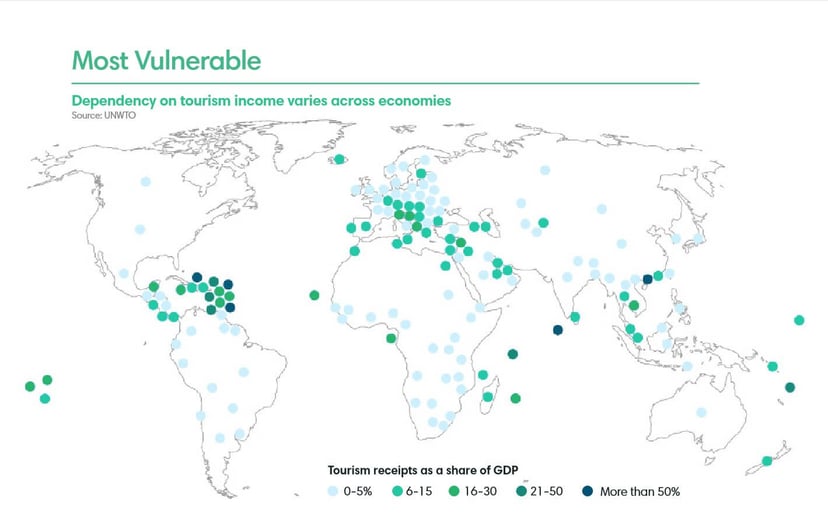
World-changing events notwithstanding, the aviation industry is not off the hook in terms of its sustainable development mandate. There is a lot of work that needs doing to support many of the SDGs and create a more sustainable industry for casual and business travelers. A number of industry organizations and travel companies have already started.
What airlines are doing
Despite what people think, aviation hasn’t been sitting back on its laurels, waiting for someone else to solve their carbon emission problem. According to the International Air Transport Association (IATA), airlines have been reducing fuel burn through weight reduction and more fuel-efficient aircraft for decades. Since 1990, carbon emissions per passenger have been reduced by more than 50%, with improvements in annual fuel efficiencies of 2.3% since 2009.
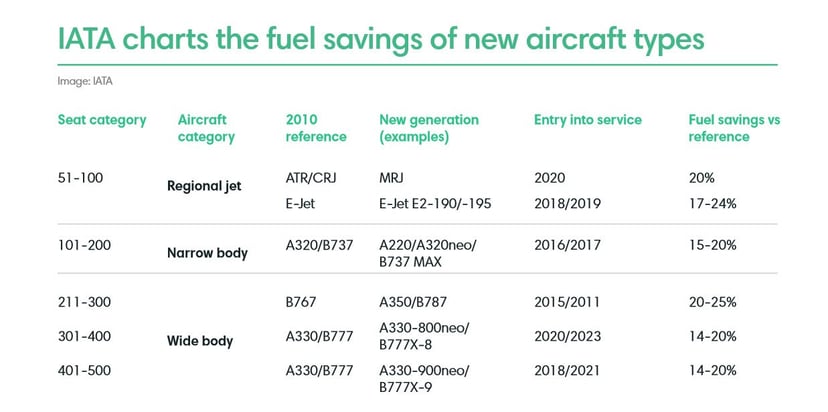
But the job is far from over; much more needs to be done. Thankfully many industry organizations like IATA and several airlines are committed to doing what needs to be done to meet their 2050 goals.
Just check the quarterly analysis report issued by CAPA - Centre for Aviation, and you’ll read about how airlines all over the world are investing in, experimenting with, and committing to new technologies to reduce their CO2 emissions.
Investing in sustainable fuel
According to Dr. Fang Liu, secretary-general for the International Civil Aviation Organization (ICAO), Sustainable Airline Fuel (SAF) options have the potential to “reduce jet fuel life-cycle CO2 emissions by up to 80%.” It won’t happen overnight, but it’s happening faster than you might think. The Air Transport Action Group (ATAG) reports that 160,000 commercial flights have already flown using SAF, and the numbers are increasing rapidly.
In 2015, United Airlines invested US$30 million in Fulcrum BioEnergy and a year later became the first US airline to use “commercial-scale volumes of sustainable biofuel” with its Eco-Skies program. In October 2019, the airline invested US$40 million towards accelerating SAF development and committed to purchasing nearly 40 million litres of SAF over the next two years. In 2020, United announced its goal of going "100% green" by 2050; the following year, the airline achieved the milestone of the first passenger flight using 100% SAF in one engine.
Ramping up production of saf
The International Civil Aviation Organization (ICAO) 2050 Vision for SAF seminar in 2019 reported that commercial production of SAF increased from an average of 0.29 million litres/year (2013-2015) to 6.45 million litres/year (2016-2018). By 2032, SAF production capacity is expected to reach 8 billion litres/year.
In 2020, JetBlue became the first US-based airline to voluntarily offset GHG emissions from all of its domestic flights. At the end of 2022, the airline announced (via a December 6 press release) that it would switch the focus of its sustainability efforts to sustainable aviation fuel.
Using SAF, JetBlue plans to effectively cut its per-seat emissions in half by 2035, stating that “JetBlue views SAF as the most promising avenue for addressing aviation emissions in a meaningful and rapid way — once cost-effective SAF is made available commercially at scale."
Then there is the work underway by the International Airlines Group (IAG), which includes brands such as British Airways, Aer Lingus, Iberia, and Vueling. IAG was the first airline group to commit to achieving net-zero carbon emissions by 2050 and the first to invest in waste-to-sustainable aviation fuels in Europe.

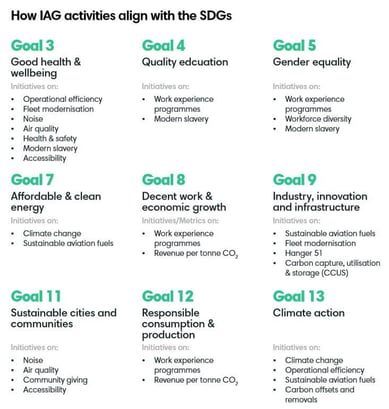
In its 2019 annual report, IAG outlined its strategic direction to meet its 2050 goals and how it will deliver on its Flightpath net-zero promise. Programs include investing in SAF, more environmentally friendly aircraft, verified carbon reduction projects and other innovative technologies to reduce its carbon footprint.
Supporting People and Prosperity
Beyond climate change and SAF programs, many airlines are addressing the sustainability needs of people and the global economy.
IAG has aligned its business initiatives around nine SDGs.
The ICAO ties its strategic objectives to 15 out of the 17 SDGs — yes, 15! And they are not alone. Other associations and their members are delivering on more SDGs than you might expect. It’s about time they started to “blow their own horns” and tell more people the good works they are doing.
In its Flying in Formation report, ATAG outlines how global aviation contributes to the UN’s 2030 Agenda for Sustainable Development. Here are just a few of the many examples you can find on its website.
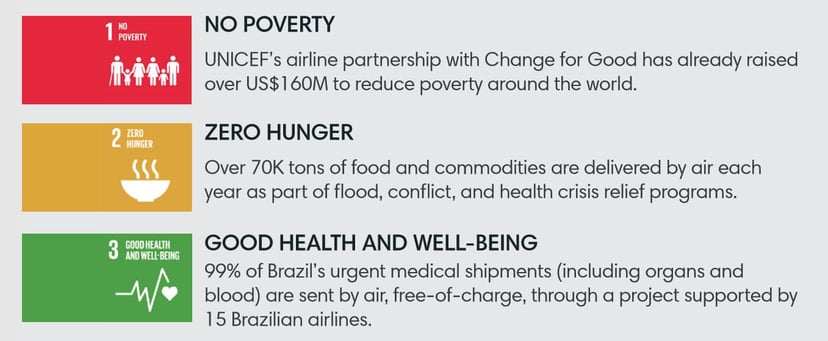
Losing weight and waste
Weight has always been a factor in reducing fuel consumption. Even as far back as 1987, airlines were looking for ways to lighten the load. It’s been reported that American Airlines removed a single olive from each of its in-flight salads, allegedly reducing fuel costs by US$40,000 a year! Crazy right? Imagine what could happen if much heavier items could be replaced with more sustainable alternatives?
Many carriers have started to remove seatback screens and drive more on-board services and media to passengers’ devices. This sustainability initiative not only reduces weight and fuel costs, it gives passengers the entertainment they want on their device of choice — smartphone, tablet or laptop.
A few years ago, PressReader partnered with the Airline Passenger Experience Association (APEX) to perform a study on the future of newspapers and magazines in-flight. At that time, 70% of airlines reported that they had already stopped offering printed media on board or planned to stop within three years due to the operating costs and environmental impact of all the extra weight and recycling costs.

Today, airlines like British Airways, Iberia, Aer Lingus, Cathay Pacific, Turkish Airlines and Air Mauritius are saving millions of dollars a year and tons of weight, simply by switching from printed media on board to digital. This allows them to reinvest those dollars to enhance the customer journey elsewhere while reducing tons of CO2 emissions.
Take Cathay Pacific, for example. It currently focuses on six SDGs and reports on its achievements for each goal in its annual Sustainability Report; digital transformation is part of the plan.
Back in 2017, we helped Cathay transition from their limited selection of printed media to thousands of digital newspapers and magazines in its lounges and on board.
Today, the airline is flying paperless in its cockpits as well, saving 13.4 million kg of weight annually and 1 million litres of aviation fuel. That’s ~4,000 tons of CO2 emission each year — the equivalent of 5,000 trips from Hong Kong to London. It’s amazing what simple changes like that can do for both the planet and people.
Iberia: an IAG inspiration
IAG brand Iberia — Spain’s number one airline — puts sustainability on the top of its agenda. It’s working on initiatives both on the ground and in the air to make flying cleaner. These initiatives include, among others, the renewal of the fleet with more efficient aircraft, electric vehicles at airports, reduction of the use of plastics, recycling of on-board waste, digitalization of processes, and the use of renewable energy in its facilities. Its reduce, reuse, and recycle program alone has decreased its waste by 23.5 tons of aluminum cans and 6.5 tons of plastic annually.
For the last decade, the airline has been working with the UNWTO as part of its sustainability commitment. In October 2019, it kicked the relationship up a notch when it signed an agreement with the UNWTO to carry out specific projects to enhance the environmental, social, and economic viability and sustainability of the tourism sector in line with the UN 2030 Agenda.
Reducing on-board waste
At the FITUR International Tourism Trade Fair in Madrid in January 2020, Iberia and PressReader won the Tourism Excellence Award for Sustainability and Green Initiatives for the project, which saw Iberia switch away from printed newspapers and magazines on its airplanes to a zero-waste digital media platform. This sustainability initiative removed over 640 tons of paper from Iberia’s aircraft — 615 tons of CO2 in one year.

We are honored to be part of Iberia’s ongoing commitment to sustainability, complementing other programs such as their Zero Cabin Waste Program, which alone saw over 2,000 tons of on-board waste separated for recycling in 2019. Not to mention in February of 2019, the airline started the year with the introduction of their latest-generation aircraft with state-of-the-art technology designed to save fuel: the Airbus A350, which lowers CO2 emissions by roughly 30%.
A colleague of mine who tested out Iberia’s paper scale at the FITUR Fair discovered that his weight equaled ~12 Iberia flights’ worth of paper saved with this one sustainability initiative.
At Iberia, we’ve substituted reading paper with its digital version: our customers can access more than 7,000 international magazines and newspapers from their devices. Less paper, less weight, less CO2 emissions.
Iberia was an earlier adopter of digital, but when COVID-19 hit the industry, and touchless travel became the new normal, the transition from paper to digital accelerated. With the adoption of new sanitized, contactless, and safe passenger experiences in airports and planes, we saw printed in-flight magazines removed from four of the top five airlines in the US. Thankfully there are easy and affordable ways to digitize them so that passengers can continue to enjoy them.
Hotels
Like airlines, hotels have a good news/bad news sustainable development story.
The good news: the hotel sector is one of the largest drivers of employment and economic revenue in the world.
The bad news: the industry is one of the most energy-intensive. When one includes other types of travel accommodation (e.g., Airbnbs, vacation rentals), the entire lodging industry accounts for almost half of tourism’s 5% GHG emissions.
But as is the case with airlines, not everyone is aware of the sustainable development happening in the industry to lessen the bad and increase the good. Here are a few examples of sustainable practices that I hope will inspire you.
MGM Resorts
MGM Resorts has been recognized as a leader in environmental sustainability for many years. I know, it’s kind of hard to believe that a Las Vegas casino and hotel chain could be sustainable. But it’s true! Since opening its first LEED certified development in 2009, MGM has built all new construction projects in the US to LEED Gold standards; 16 of its properties have earned Green Key awards, and eight have earned Green Globe certification.

A few years ago, MGM’s ARIA Resort and Casino hosted Verified — The Forbes Travel Guide Luxury Summit — one of the most prestigious events in the world. The PressReader team was there, and I was shocked, in a good way, to see how opulence can still be so sustainable.
ARIA is one of the largest LEED Gold-certified buildings in the world and is one of the most comfortable and luxurious hotels I’ve ever seen.
To help the hotel group make positive impacts on its communities, MGM Resorts selected 10 SDGs to inspire its strategy for social and environmental impacts. It wrapped those goals within four pillars:
Here are just a few things MGM Resorts has achieved in support of sustainable development across these four commitments.
-
MGM Resorts is consistently named one of the “Best places to work for LGBTQ+ equality” by the Human Rights Campaign Foundation’s Corporate Equality Index.
-
MGM Resorts donated more than 1.1 million meals in 2020, amounting to a cumulative total of 2.6 million meals donated since its Feeding Forward program began in 2016. When its resorts were closed during the pandemic, the company donated more than 662,000 pounds of food to to feed local people in the communities in which its operates.
-
MGM also kept over 200,000 tons of food waste from landfills over 12 years — the equivalent of 1,000 blue whales.
-
In 2020, MGM Resorts broke ground on a utility-scale 100-megawatt solar array, which will drive ~90% of the daytime electricity needed in all of its properties on the Vegas Strip.
Scandic Hotels
With 58,000 rooms in six countries, Scandic Hotels, headquartered in Stockholm, Sweden, is the largest hotel operator in the Nordic countries.
Way back in 1993, it decided it was going to be a leader in sustainability in the hospitality sector, and engage its team members to achieve that. That same year an employee’s “Hang up your towel” initiative became a hospitality standard policy worldwide.
In 2001, the hotel chain introduced “Scandic in Society” to engage staff in giving back to communities. Every year, thousands of team members across all Scandic hotels participate in projects such as cleaning up beaches, visiting children in local hospitals, planting trees in ravaged forests, and providing bedding in shelters for the homeless.
Since Scandic doesn’t own any hotel buildings, it continually encourages the property owners to implement measures to reduce their negative environmental impacts and help Scandic meet its CO2 emission targets.
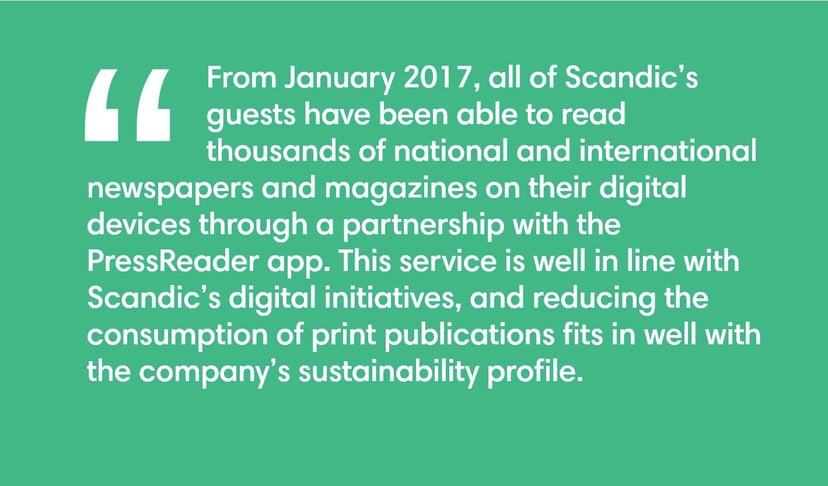
It also practices sustainable development in managing its supply chains, human resource policies, waste management, energy conservation, sustainable guest services and amenities. And it does it better than most.
Five years ago, its entire suite of hotels converted from print to digital media in its efforts to reduce its use of paper and carbon footprint. According to a 2017 Scandic press release,
In 2018, more than 18,000 employees joined in on a sustainability hackathon, which resulted in 400 environmental and social ideas being presented to a jury. The winning proposal was “Turn off the tap when brushing your teeth,” which was piloted in Norway in 2019 with a target of saving over 150 millions litres of water a year.
In 2023, the Sustainable Brand Index, Europe’s largest brand study on sustainability, named Scandic the best in the industry in Sweden for the 13th consecutive year.
NH Hotel Group
Headquartered in Madrid with over 350 hotels in 28 countries, NH Hotel Group has been diligently decreasing its carbon dioxide emissions through sustainability programs.
Over the past decade, it reduced its carbon footprint by 70%, cut energy use by 28%, and water costs by 30%.
Through its CORK2CORK program, NH Hotel Group SA collected cork stoppers from wine bottles from 74 hotels in Spain and Italy, recycled them and reused them for cladding and insulation in 300 new rooms. The recycles material not only acts as a heat insulator, it also reduces noise. Their commitment to improve waste management and contribute to the circular economy won the hotel group a Grupo Excelencias International Award at FITUR 2020.
NH also stopped distributing printed media in their hotels and began providing free access to a thousands of digital newspapers and magazines to its guests. The results speak for themselves.

The new normal
According to the United Nations World Tourism Organization the COVID-19 pandemic represented “the worst crisis that international tourism has faced since records began (1950).” The tourism industry has bounced back in a major way since international travel opened up again. A lot of damage was already done, though, and the hospitality sector is still struggling with an ongoing shortage of workers.
If there’s any possible silver lining, perhaps it’s that people have woken up to how critical the development of a more sustainable tourism industry is to the global economy and the well-being and livelihoods of the world’s most vulnerable citizens.
In closing, I hope that every person or business in the travel and tourism value chain — booking agents, hotels, airlines, tour operators, restaurants and travelers — will take time to reflect on the past in terms of their priorities and actions: what they did right pre-COVID, what they did wrong or didn’t do enough of, and what they can do better to contribute to the development of sustainable tourism.
Measuring your carbon footprint, and changing your behavior to lower it, is a great start, but it’s not nearly enough. As global citizens, all of us — not just those in the travel and tourism industry — need to commit to supporting not one or two Sustainable Development Goalss, but all 17 in our day-to-day lives. We need to act if our lives depend on it. Because the fact is, they do.
I’ve got my list, and I’d love to hear about yours. Let’s talk!
This is an updated version of an article that originally appeared in the July 2020 issue of The Insider.







